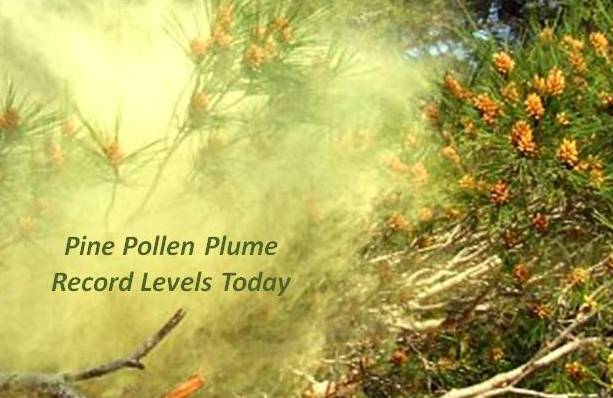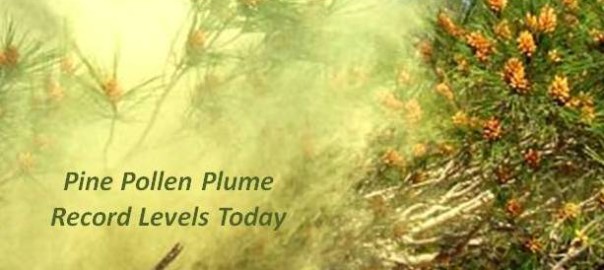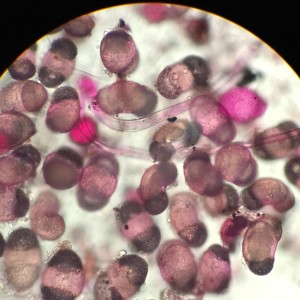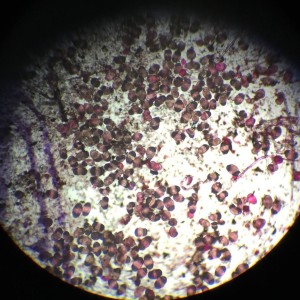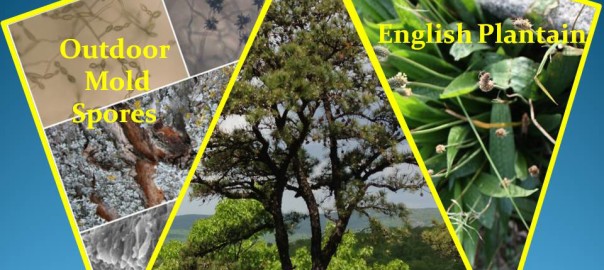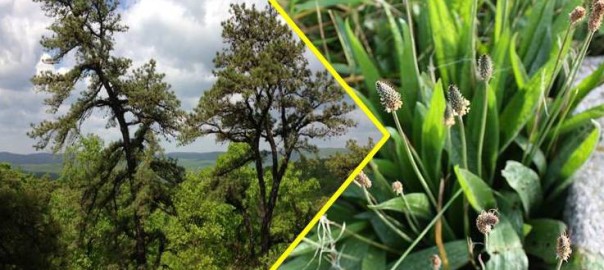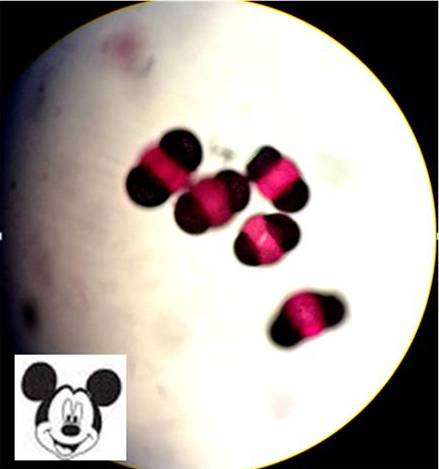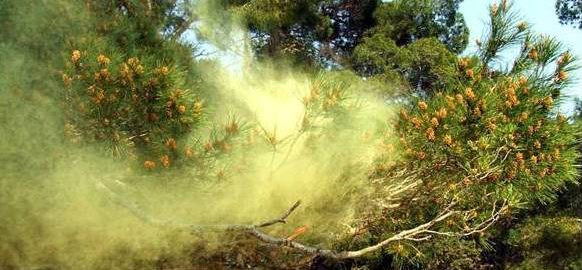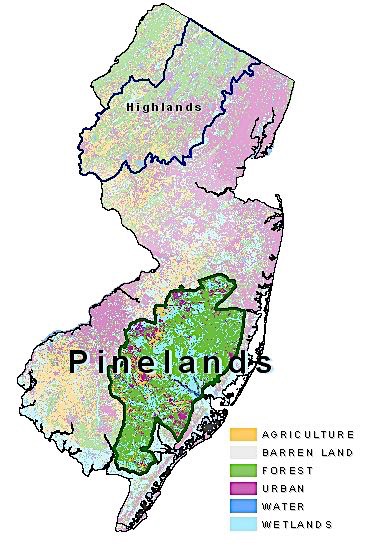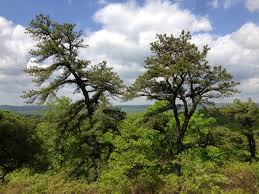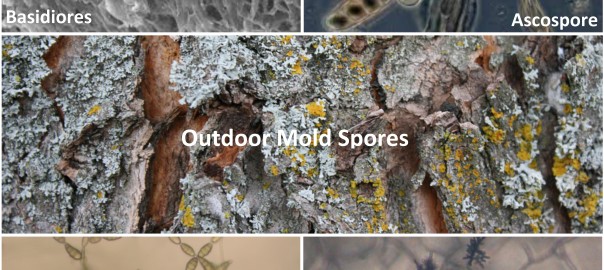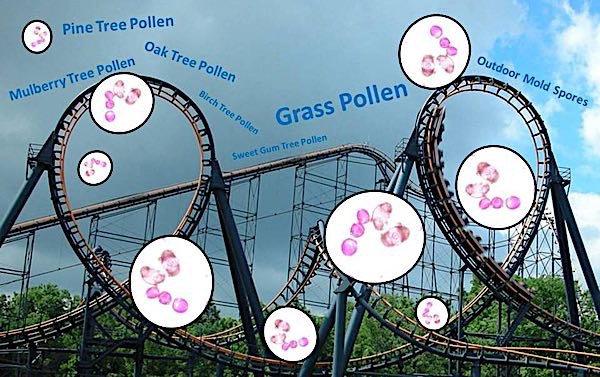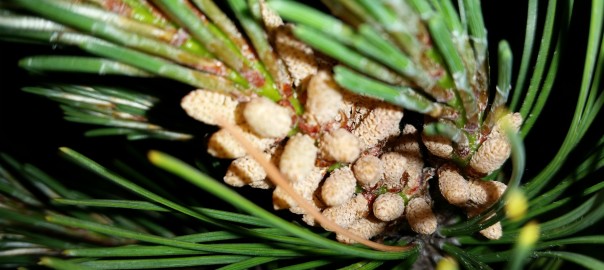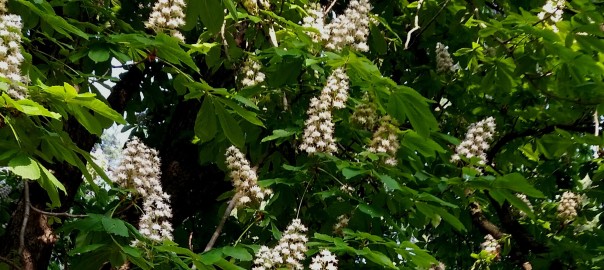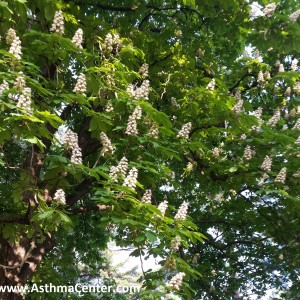For interviews and tours of the Delaware Valley’s only certified pollen and mold spore stations for the National Allergy Bureau (NAB) with stations, please email gwoodlyn@asthmacenter.com
“Pine pollen is extreme today,” says Dr. Dvorin “Sudden hot temperatures, less rain than expected, and more wind—all these weather conditions likely led to today’s surge in Pine pollen, and outdoor mold spores are extreme too!”
Today’s count is the highest Pine Tree Pollen count observed in the Delaware Valley since May, 2012.
Pine Tree Pollen is extreme at nearly 1200 grains per cubic meter of air/24 hours.
Below are two images of Pine Tree Pollen from today’s air sample taken by Dr. Dvorin right from his microscope. The image on the left was taken at a higher power while the image on the right was taken at a lower power.
Pine Pollen Allergy Alert
When you compare today’s images above, especially the higher power image on the left, with the below image which was taken by Dr. Dvorin on 5/19/2016 to illustrate the “Mickey Mouse” appearance of Pine Pollen grains , the difference in volume is dramatic.
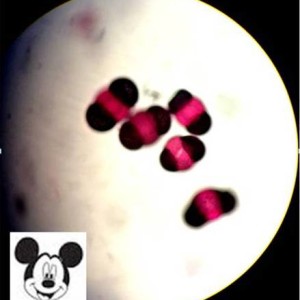
Despite the abundance of pine pollen in our air samples, pine pollen allergy is often ignored.
“For individuals who today are sneezing, itching, have itchy watery eyes and/or other allergy & asthma symptoms, exposure to multiple aeroallergens—what’s in the air—especially pine pollen in our air matters now,” explains Dr. Goldstein. “Pine pollen makes our region unique from an allergy perspective compared to other areas of the Northeastern U.S. where pine pollen is minimal, nonexistent, or other species are prevalent.”
Is Pine Pollen Allergy playing a role in your symptoms?
The Asthma Center routinely tests for pine pollen sensitivity —contact the office location near you to schedule an appointment! For more information on Pine Pollen Allergy, be sure to read our recent blog “Pine: Star Player Triples – Mold Batting Cleanup”
Today’s only official Pollen & Mold Spore Counts for the Delaware Valley:
Overall Tree Pollen Volume and Pine Tree Pollen both increased more than 60% today compared to Friday’s count.
At nearly 1300 pollen grains per cubic meter of air, Tree Pollen is extreme and may provoke severe symptoms. (any count above 1000 is extreme – see How We Count Pollen)
Predominant: Pine Tree Pollen alone is nearly 1200 (also extreme) and today accounts for more than 90% of all tree pollen currently in the air.
Other tree pollen observed in today’s sample include Mulberry, Oak, Walnut, Sweet Gum, Hickory/Pecan, Birch, Ash, & Juniper.
Grass Pollen has remains High. Are you ready? For tips on Grass Pollen Preparedness, read our 5/9 blog Extreme Tree + More Grass & Molds = Misery Monday
Outdoor Mold Spores have nearly around 40% compared to Friday’s count.
At well over 7700 spores per cubic meter of air for 24 hours, Outdoor Mold Spores are extreme and may provoke severe symptoms.
For more on Outdoor Mold Spores and mold allergy, be sure to read our 5/24 blog Rain Brings Trouble As Mold Spores Double
Weed Pollen is moderate. The only weed pollen in the air today is plantago lanceolata (more commonly known as English Plantain.)
For more information on English Plantain, check out the 5/26/2016 pollen blog Pine & Weed Double Header.
If you would like to know if English Plantain weed pollen allergy is playing a role in your symptoms, The Asthma Center does routinely test for pine pollen sensitivity and English Plantain weed pollen sensitivity—contact the office location near you to schedule an appointment!
What Can you do?
Be sure to check back in for The Asthma Center’s daily Pollen and Mold Spore Count, the Delaware Valley’s only Official count station which is certified by the National Allergy Bureau. Subscribe to receive our daily counts by email or check out some of our other blog posts to learn more about what is in the air, how it can affect you, and what you can do about it.
Are you taking too much or too little medication? Are your allergy symptoms (or side effects from too much medication) inferring with your quality of life?
At The Asthma Center, we know that no two individuals are alike, and our goal is to personalize your treatment to help you find relief. We accomplish this through identifying your allergies and specific levels of allergic sensitivity through allergy skin testing to help you plan your treatment.
Once a treatment plan is in place, we work with you to correlate your symptoms by following the local pollen counts. This allows us to customize treatment for your specific situation and therefore prevent and/or treat symptoms by making sure that you know how to adjust your medications up and down and take just the right amount!
Make an appointment to see one of our board certified allergists – Why Choose Us?
The best way to fight your allergies is to visit a board certified allergist, learn what your allergies are, create a treatment plan, and adjust as needed. No two allergy sufferers are alike, so don’t rely on over the counter medications—call a location near you now and be sure to ask about our special Saturday hours!

